Abstract
Lysinuric protein intolerance (LPI) is an autosomal recessive defect of diamino acid transport characterised by massive diaminoaciduria, especially lysinuria, with hyperammonaemia after heavy nitrogen intake. The defect has previously been demonstrated in the kidney, and is probably present in the liver cells. To evaluate the effect of the LPI gene on the net intestinal absorption of the diamino acids and citrulline, separate oral loads of each were given to controls, and to subjects heterozygous and homozygous for LPI. In the affected subjects the plasma concentrations of the loaded diamino acids showed lower increments after the loads than in the controls, the difference being marked in the homozygotes and moderate in the heterozygotes. Urinary excretion failed to explain these differences. Thus, the diamino acid transport defect of LPI is also present in the intestine. After citrulline loads, in contrast, plasma citrulline levels rose similarly in controls and homozygotes. Thus, LPI is associated with intact citrulline absorption. The ornithinopenic hyperammonaemia of LPI is probably preventable by supplementing dietary protein with the ornithine precursor citrulline.
Full text
PDF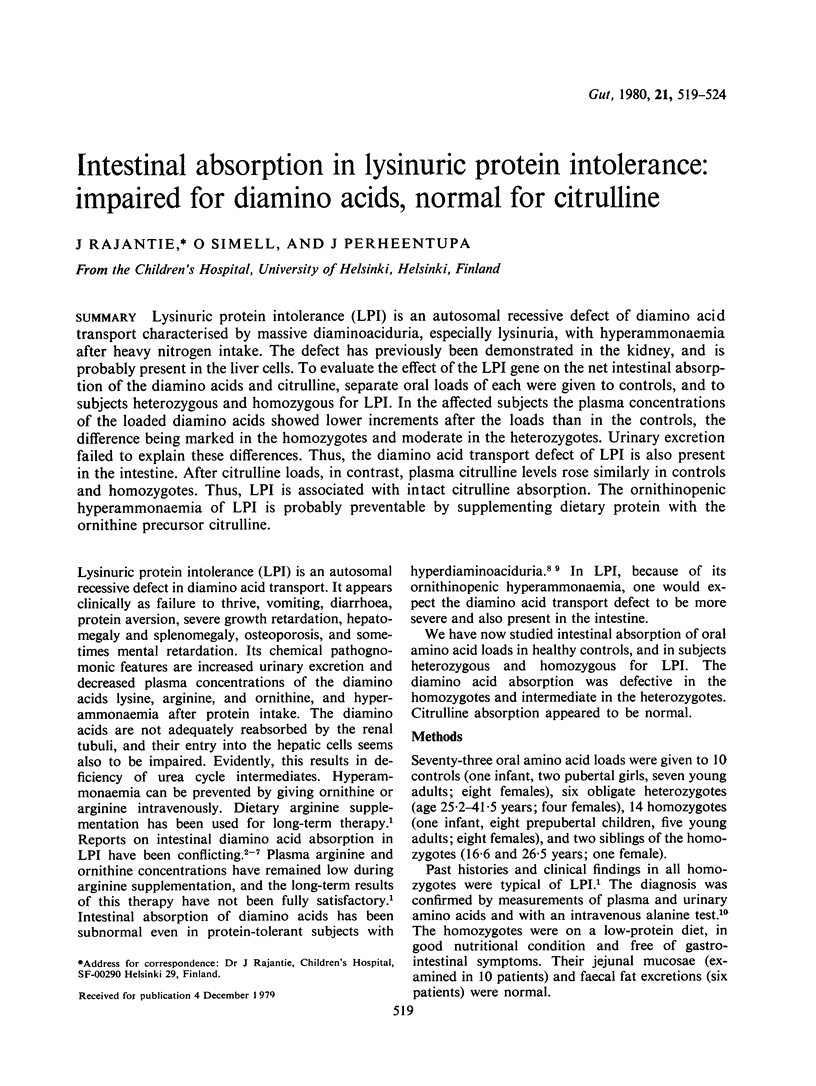
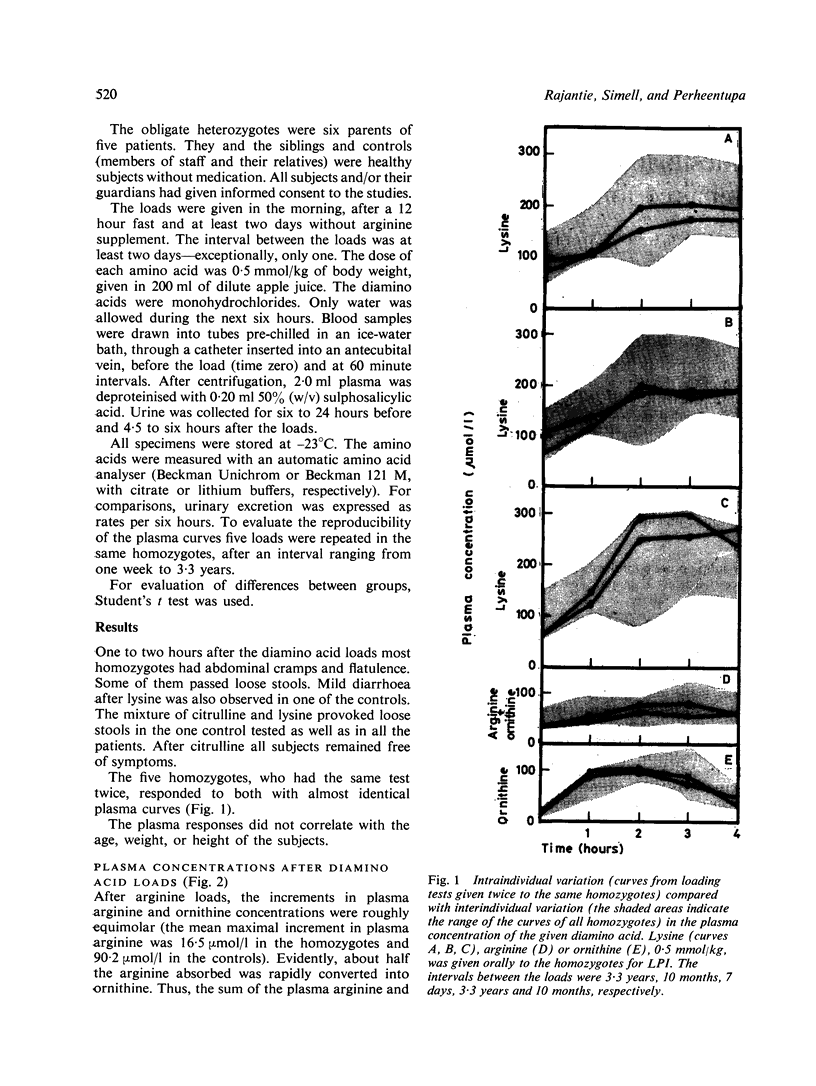
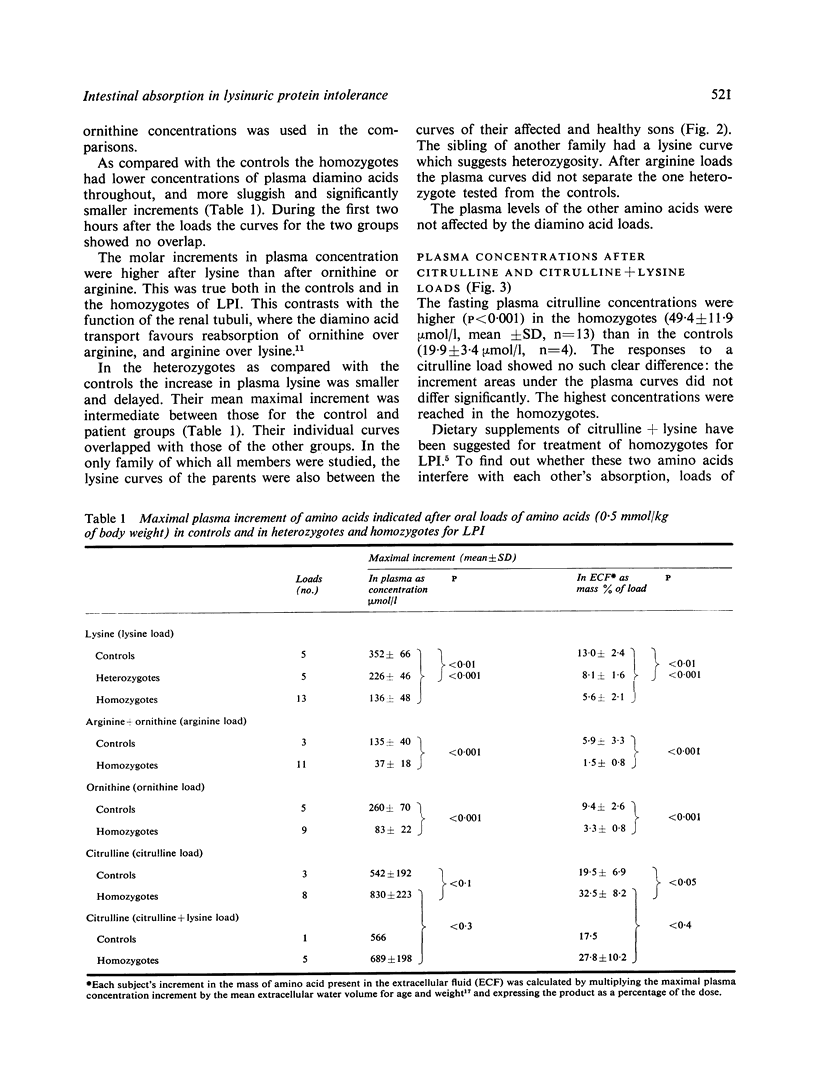
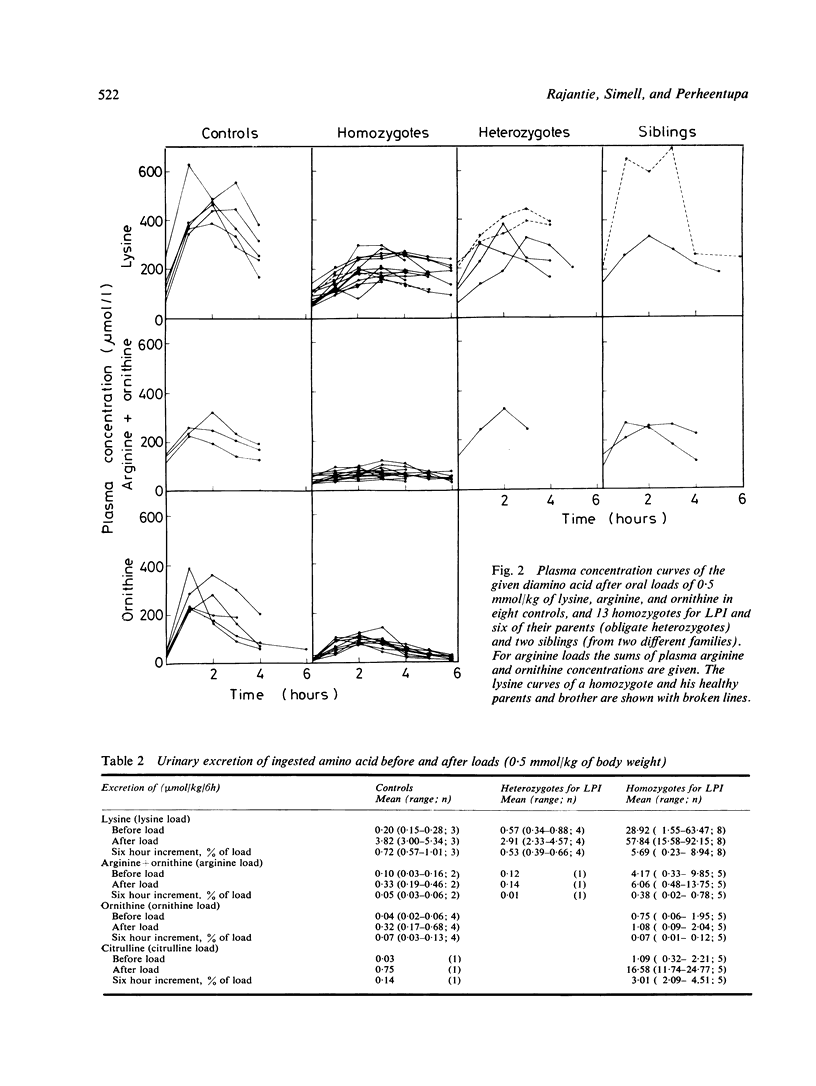
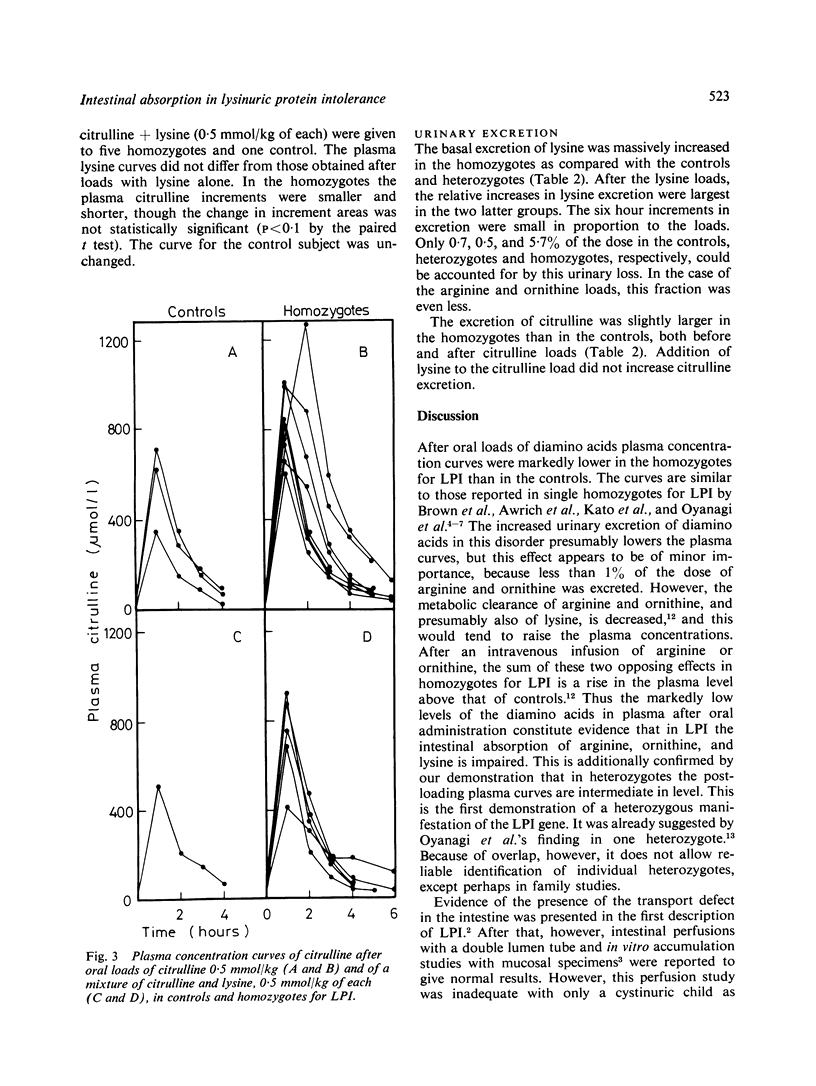
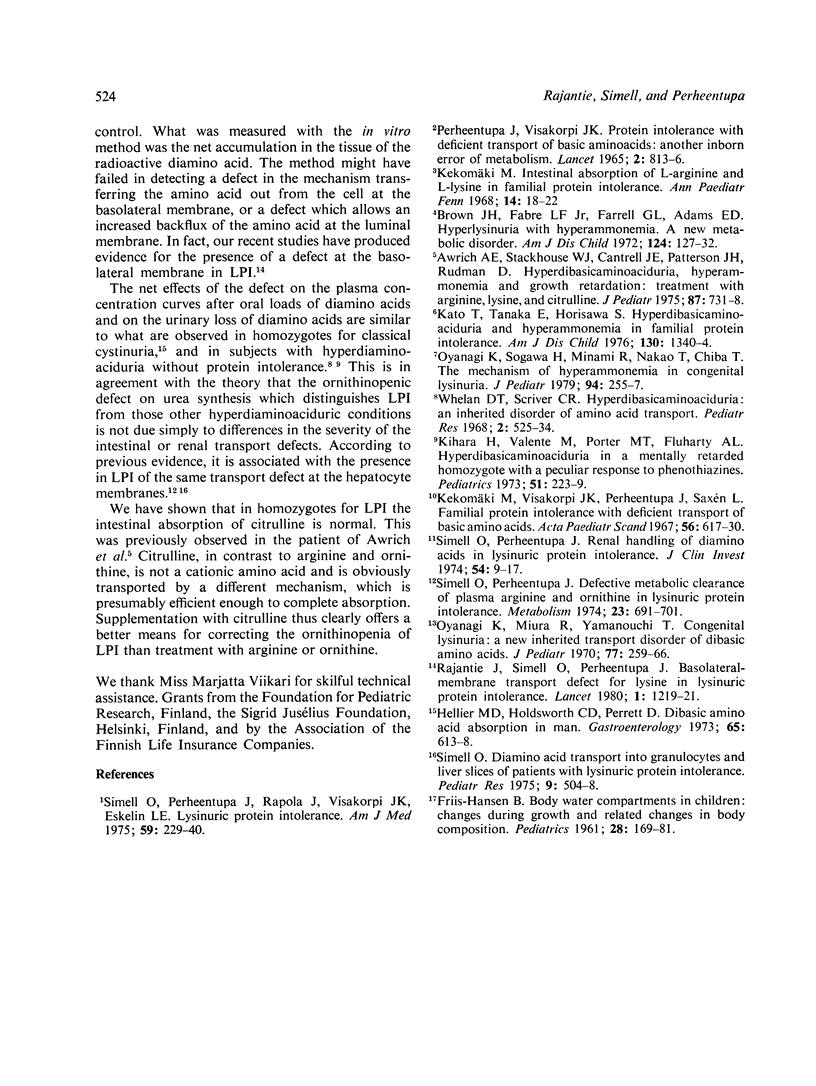
Selected References
These references are in PubMed. This may not be the complete list of references from this article.
- Awrich A. E., Stackhouse W. J., Cantrell J. E., Patterson J. H., Rudman D. Hyperdibasicaminoaciduria, hyperammonemia, and growth retardation: Treatment with arginine, lysine, and citrulline. J Pediatr. 1975 Nov;87(5):731–738. doi: 10.1016/s0022-3476(75)80296-4. [DOI] [PubMed] [Google Scholar]
- Brown J. H., Fabre L. F., Jr, Farrell G. L., Adams E. D. Hyperlysinuria with hyperammonemia. A new metabolic disorder. Am J Dis Child. 1972 Jul;124(1):127–132. doi: 10.1001/archpedi.1972.02110130129021. [DOI] [PubMed] [Google Scholar]
- FRIIS-HANSEN B. Body water compartments in children: changes during growth and related changes in body composition. Pediatrics. 1961 Aug;28:169–181. [PubMed] [Google Scholar]
- Hellier M. D., Holdsworth C. D., Perrett D. Dibasic amino acid absorption in man. Gastroenterology. 1973 Oct;65(4):613–618. [PubMed] [Google Scholar]
- Kato T., Tanaka E., Horisawa S. Hyperdibasicaminoaciduria and hyperammonemia in familial protein intolerance. Am J Dis Child. 1976 Dec;130(12):1340–1344. doi: 10.1001/archpedi.1976.02120130046010. [DOI] [PubMed] [Google Scholar]
- Kekomäki M. Intestinal absorption of L-arginine and L-lysine in familial protein intolerance. Ann Paediatr Fenn. 1968;14(1):18–22. [PubMed] [Google Scholar]
- Kekomäki M., Visakorpi J. K., Perheentupa J., Saxén L. Familial protein intolerance with deficient transport of basic amino acids. An analysis of 10 patients. Acta Paediatr Scand. 1967 Nov;56(6):617–630. doi: 10.1111/j.1651-2227.1967.tb15988.x. [DOI] [PubMed] [Google Scholar]
- Kihara H., Valente M., Porter M. T., Fluharty A. L. Hyperdibasicaminoaciduria in a mentally retarded homozygote with a peculiar response to phenothiazines. Pediatrics. 1973 Feb;51(2):223–229. [PubMed] [Google Scholar]
- Oyanagi K., Miura R., Yamanouchi T. Congenital lysinuria: a new inherited transport disorder of dibasic amino acids. J Pediatr. 1970 Aug;77(2):259–266. doi: 10.1016/s0022-3476(70)80333-x. [DOI] [PubMed] [Google Scholar]
- Oyanagi K., Sogawa H., Minami R., Nakao T., Chiba T. The mechanism of hyperammonemia in congenital lysinuria. J Pediatr. 1979 Feb;94(2):255–257. doi: 10.1016/s0022-3476(79)80838-0. [DOI] [PubMed] [Google Scholar]
- Perheentupa J., Visakorpi J. K. Protein intolerance with deficient transport of basic aminoacids. Another inborn error of metabolism. Lancet. 1965 Oct 23;2(7417):813–816. doi: 10.1016/s0140-6736(65)92446-3. [DOI] [PubMed] [Google Scholar]
- Rajantie J., Simell O., Perheentupa J. Basolateral-membrane transport defect for lysine in lysinuric protein intolerance. Lancet. 1980 Jun 7;1(8180):1219–1221. doi: 10.1016/s0140-6736(80)91679-7. [DOI] [PubMed] [Google Scholar]
- Simell O. Diamino acid transport into granulocytes and liver slices of patients with lysinuric protein intolerance. Pediatr Res. 1975 May;9(5):504–508. doi: 10.1203/00006450-197505000-00008. [DOI] [PubMed] [Google Scholar]
- Simell O., Perheentupa J. Defective metabolic clearance of plasma arginine and ornithine in lysinuric protein intolerance. Metabolism. 1974 Aug;23(8):691–701. doi: 10.1016/0026-0495(74)90001-8. [DOI] [PubMed] [Google Scholar]
- Simell O., Perheentupa J., Rapola J., Visakorpi J. K., Eskelin L. E. Lysinuric protein intolerance. Am J Med. 1975 Aug;59(2):229–240. doi: 10.1016/0002-9343(75)90358-7. [DOI] [PubMed] [Google Scholar]
- Simell O., Perheentupa J. Renal handling of diamino acids in lysinuric protein intolerance. J Clin Invest. 1974 Jul;54(1):9–17. doi: 10.1172/JCI107753. [DOI] [PMC free article] [PubMed] [Google Scholar]
- Whelan D. T., Scriver C. R. Hyperdibasicaminoaciduria: an inherited disorder of amino acid transport. Pediatr Res. 1968 Nov;2(6):525–534. doi: 10.1203/00006450-196811000-00011. [DOI] [PubMed] [Google Scholar]


